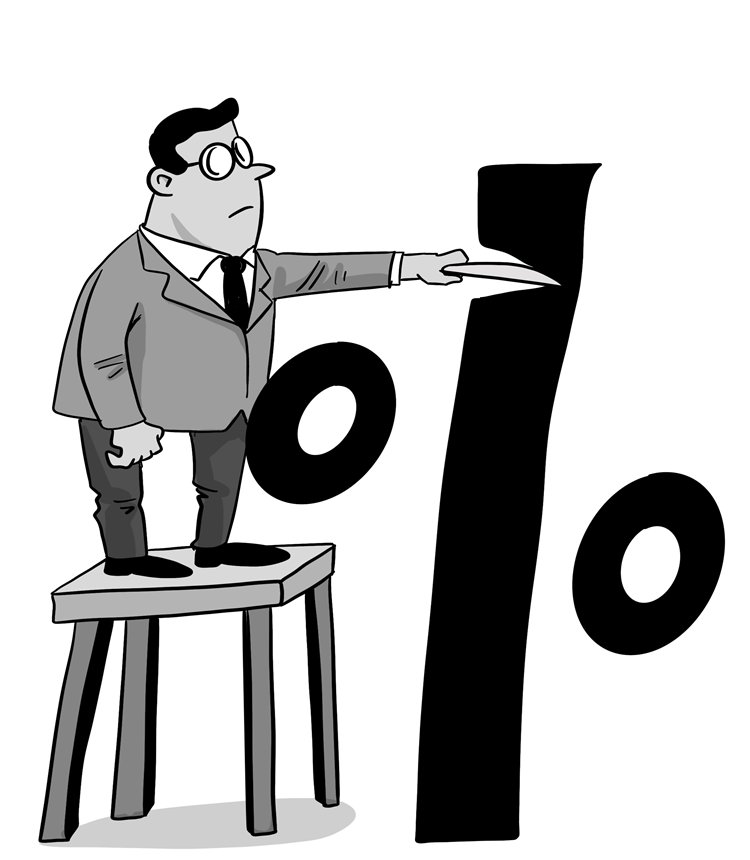HOME >> BUSINESS
China can afford a looser monetary policy while MLF rate cut may signal lower LPR
By Zhou Qing Source:Global Times Published: 2019/11/6 19:01:27

Illustration: Luo Xuan/GT
China's monetary policy may switch gears in the coming months with the recent interest rate cut of its medium-term lending facility (MLF) signaling a lower loan prime rate (LPR). A Stronger yuan against the US dollar also provides more policy maneuvers for the Chinese monetary authority to follow suit in the new trend of global monetary easing.
The People's Bank of China, China's central bank, on Tuesday cut interest rates by 5 basis points from 3.3 percent to 3.25 on its one-year, medium-term lending facility (MLF) for the first time in over a year. The one-year MLF interest rate, which serves as an LPR anchor, will likely drive the base rate lower to around 4.2 percent compared to the current 4.25 percent. Markets reacted positively to the news. Chinese A shares rallied the same day with banks and securities taking the lead.
China's prudent monetary policy has been holding water, particularly against the background of a new round of global easing. The US Federal Reserve (Fed) trimmed its benchmark fund rate by 25 basis points on October 30 to a range of 1.5 percent to 1.75 percent, right after the government reported GDP growth had slowed to 1.9 percent the same day. The European Central Bank cut its interest rate into negative territory and restored bond-purchasing programs in September in an effort to boost the EU's sluggish economy.
Global economic recession and a trade war with the US that has lasted over 16 months have weighed on the Chinese economy. The country's GDP growth rate experienced a mild decline to 6 percent. Exports in September decreased slightly. The Purchasing Managers' Index, a measure of performance in the manufacturing and services sectors, has been shifting back and forth around the 50 percent benchmark throughout the year, with figures falling below 50 percent for six consecutive months. The Chinese economy could use a lower interest rate as a boost.
In August, the PBC decided to improve the formation mechanism of the LPR, which was first launched in 2013 as part of the central bank's efforts to build a more market-oriented interest rate. A slew of measures have been rolled out in the past few months to clear the path further for the LPR transmission mechanism.
The LPR is gradually gaining broader influence. December 31 this year will mark the check point for the LPR's implementation - national banks and financial institutions are required to peg at least 50 percent of loans issued with the LPR. The ratio will increase to 80 percent at the end of March next year.
Aside from a more market-sensitive LPR, China has enough policy leeway to adjust its economic situation, unlike the US and the EU. The Chinese economy, despite signs of deceleration, is still resilient. The country remains likely to reclaim its title of the world's fastest growing economy in 2019, as the Indian economy has hit a bumpy road this year. Prudent monetary policy has been the foundation of China's monetary policy for years, and the PBC has been using monetary tools with discretion.
Moreover, the yuan's depreciation pressure has been alleviated. Both the onshore and offshore yuan to US dollar exchange rate on Tuesday have managed to climb back above 7, a key psychological level, three months after the yuan first slipped pass 7 on August 5. Despite a solid labor market, the US' manufacturing, investment and export sectors have become flaggy. Together with the Fed's interest rate cuts, which have occurred three times this year, the US dollar has weakened. A lower LPR may raise concerns over potential inflation since China's consumer price index in September was 3 percent, the highest figure in six years. However, this inflation was mainly driven by pork prices which rose due to the global outbreak of African swine fever. Chinese policymakers have actively dealt with the situation and are maintaining the price at controllable level.
China's current situation means its central bank can afford lower interest rates. If there is a new wave in the global economic downturn, China is better prepared and has more countermeasures in the bag than other countries like the US.
The author is a reporter with the Global Times. bizopinion@globaltimes.com.cn
Posted in: EXPERT ASSESSMENT